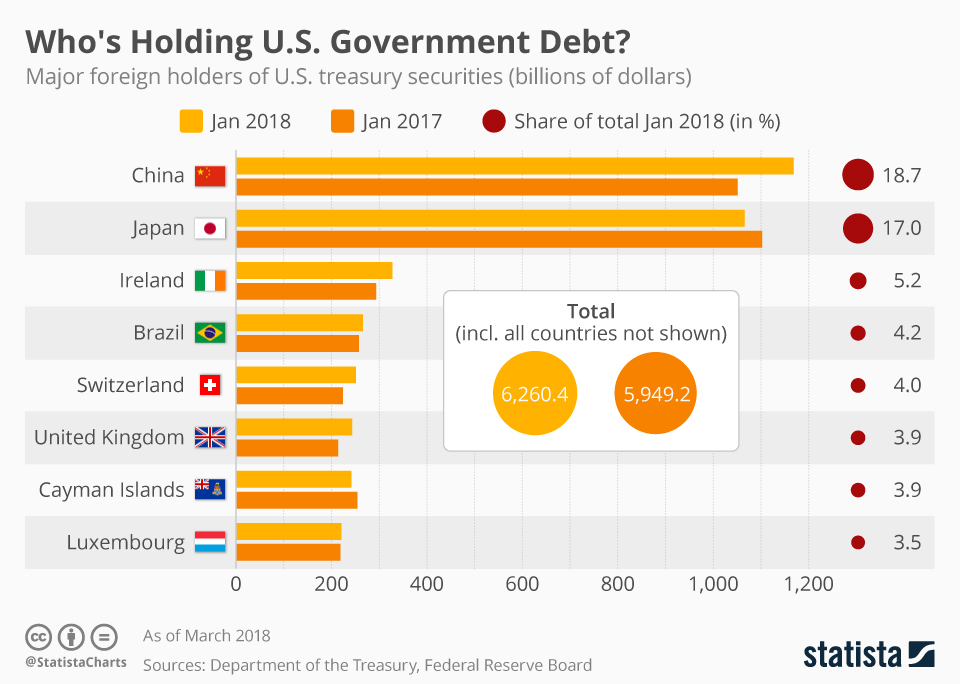Introduction
Which factors are likely to be important and dominate the EUR/USD exchange rate during the next few years? We are going to discuss fundamental and technical evidence for the most important currency pair worldwide. Our results suggest that the US Dollar is still within a secular bear trend versus the Euro.
Fundamentals
US American trade policy as well as geopolitical trends paint a bearish picture for the US Dollar. The Trump administration’s policies are implicitly and explicitly targeting a weak greenback. Moreover, bullish EUR/USD pressure is likely to build from Europe as a result of its geopolitical situation.
US Trade Policy
Trump’s “AmericaFirst” policy has two non-negligible effects on US Dollar demand.First of all,it obviously decreases demand for foreign products and increases demand for US products. Consequently, this causes negative pressure for the US dollar. Second, some of the parties that are severely affected by US trade policy are among the biggest holders of Dollar denominated debt. Theyhave a big interest to diversify their US dollar exposure into other currencies. This is an ongoing processalready. The Chinese crude oil future market is one example of that. The recent German call for an independent international payment system is another example. Meanwhile, the US President and Treasury Secretary are doing their part to set stage for a weaker dollar. Throughout recent history, US policymakers were at least verbally favouring a strong dollar. That’s not the case anymore. Trump and Mnuchin do not signal to have any interest in a strong US Dollar. All in all, political factors from the United States are bearish for the US dollar.
European Union
The geopolitical situation in Europe adds to the case of a weaker US Dollar versus the Euro. The Brexitwas the first major anti-European vote but may not be the final one. TheTimbro Authoritarian Populism Index shows the average share of votes for populist parties in Europe. The chart suggests that Europe is withina slow but clear trend of rising populism. Opposition of a European integration is one key element that unites European populist. Hence, there is a non-negligible probability that some of the EU members will be leaving the EU in favour of their own sovereignty during the next few years.
Why should that have bullish implications for the Euro? Regional data for 26 European countries suggest a positive correlation for unemployment and populist voting. Moreover, European fiscal and monetary policy as it happens today is probably inappropriatefor the weakest EU economies. Countries like Greece and Italy would most likely benefit from an expansive monetary and fiscal policy. Moreover, a drachma or lira would probably float far below the Euro value improving their competitiveness. There are simply more arguments for weaker European economies to leave the Euro then for stronger ones. After all, a German exit scenario probably results in a very strong German currency. Trade barriers and a20%-30% currency appreciation is not a favourable scenario for the export-oriented German economy. Instead, it Ismore likely that economically weaker Euro countries turn their back on theEU during the next few years. This in turn means upward pressure on theEuro. Hence, the populism trend is rather bullish for the Euro currency.
Technical Evidence
The US dollar has been appreciating versus the Euro basket for the past few decades. Moreover, we do not have sufficient evidence for a reversal of this secular trend. The graph shows higher highs and higher lows over the past 40 years. As simple as it is, this is an upside trend.
Moreover, we see a couple of 3-wavemoves into the past couple of higher highs. That’s not a valid termination of a trend in an Elliott wave framework. It is more likely some diagonal pattern, which still unfolds.We do not have to worry whether we are dealing with an ending or a leading diagonal at this stage. It still needs another leg to the upside before completion. Another leg implies an entire cycle of bullish Euro action. The upside leg is depicted in our Elliott wave chart. It paints a bullish EUR picture within an Elliott wave framework. All in all, the EUR/USD is likely to unfold an A-B-C wave sequence of intermediate degree to the upside in order to complete a paramount degree diagonal pattern.
The technical outlook does not suggest that the US Dollar is depreciating from tomorrow on. As a matter of fact, the recent Dollar strength is likely to persist for another few months. However, this is subject to a shorter time-frame analysis, which is not part of our long-term case here.
Conclusion
Fundamental and technical evidence suggest that the US Dollar is likely to depreciate versus the Euro during the next few years. Fundamentals are driven by policy and geopolitical trends on both sides of the Atlantic. The technical picture shows a secular bear market for the US Dollar. There is simply not enough evidence that this secular trend reversed within an Elliott wave framework.
All in all, the US Dollar is likely to continue weakening versus the Euro during the next few years. The most recent US Dollar strength is probably just another countertrend correction.
Interested in more of our ideas? Check out Scienceinvesting for more details!
The above is a matter of opinion provided for general information purposes only and is not intended as investment advice. Information and analysis above are derived from sources and utilising methods believed to be reliable, but we cannot accept responsibility for any losses you may incur as a result of this analysis. Individuals should consult with their personal financial advisors. Reproduction without ESI Analytics’ prior consent is strictly forbidden.
Recommended Content
Editors’ Picks

EUR/USD keeps the range bound trade near 1.1350
After bottoming near the 1.1300 level, EUR/USD has regained upward momentum, pushing toward the 1.1350 zone following the US Dollar’s vacillating price action. Meanwhile, market participants remain closely tuned to developments in the US-China trade war.

GBP/USD still well bid, still focused on 1.3200
The Greenback's current flattish stance lends extra support to GBP/USD, pushing the pair back to around the 1.3200 level as it reaches multi-day highs amid improved risk sentiment on Monday.

Gold trades with marked losses near $3,200
Gold seems to have met some daily contention around the $3,200 zone on Monday, coming under renewed downside pressure after hitting record highs near $3,250 earlier in the day, always amid alleviated trade concerns. Declining US yields, in the meantime, should keep the downside contained somehow.

Six Fundamentals for the Week: Tariffs, US Retail Sales and ECB stand out Premium
"Nobody is off the hook" – these words by US President Donald Trump keep markets focused on tariff policy. However, some hard data and the European Central Bank (ECB) decision will also keep things busy ahead of Good Friday.

Is a recession looming?
Wall Street skyrockets after Trump announces tariff delay. But gains remain limited as Trade War with China continues. Recession odds have eased, but investors remain fearful. The worst may not be over, deeper market wounds still possible.

The Best brokers to trade EUR/USD
SPONSORED Discover the top brokers for trading EUR/USD in 2025. Our list features brokers with competitive spreads, fast execution, and powerful platforms. Whether you're a beginner or an expert, find the right partner to navigate the dynamic Forex market.


